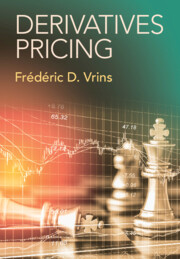Refine search
Actions for selected content:
134 results
Saving the reliability of inhibitory control measures? An extension of Huensch (2024) and Hui and Wu (2024)
-
- Journal:
- Studies in Second Language Acquisition , First View
- Published online by Cambridge University Press:
- 12 August 2025, pp. 1-21
-
- Article
-
- You have access
- Open access
- HTML
- Export citation
A Philosophical Metabolism Problem: Undermining of Egoistic Reasons
-
- Journal:
- Utilitas , First View
- Published online by Cambridge University Press:
- 23 July 2025, pp. 1-16
-
- Article
-
- You have access
- Open access
- HTML
- Export citation

Derivatives Pricing
-
- Published online:
- 08 July 2025
- Print publication:
- 20 March 2025
-
- Textbook
- Export citation
General Introduction
-
- Book:
- Derivatives Pricing
- Published online:
- 08 July 2025
- Print publication:
- 20 March 2025, pp xix-xxx
-
- Chapter
- Export citation
9 - Derivative Pricing Using CRR
- from Part II - Pricing by Risk-Neutral Expectation
-
- Book:
- Derivatives Pricing
- Published online:
- 08 July 2025
- Print publication:
- 20 March 2025, pp 213-242
-
- Chapter
- Export citation
16 - The Black–Scholes–Merton Equation
- from Part III - Pricing by Dynamic Replication
-
- Book:
- Derivatives Pricing
- Published online:
- 08 July 2025
- Print publication:
- 20 March 2025, pp 345-353
-
- Chapter
- Export citation
Best practices in replication: a case study of common information in coordination games
-
- Journal:
- Experimental Economics / Volume 24 / Issue 1 / March 2021
- Published online by Cambridge University Press:
- 14 March 2025, pp. 2-30
-
- Article
-
- You have access
- Open access
- HTML
- Export citation
Measuring conditional cooperation: a replication study in Russia
-
- Journal:
- Experimental Economics / Volume 12 / Issue 1 / March 2009
- Published online by Cambridge University Press:
- 14 March 2025, pp. 87-92
-
- Article
- Export citation
3 - Hurricane Names
- from Part II - The Computational Multiverse
-
- Book:
- Multiverse Analysis
- Published online:
- 28 February 2025
- Print publication:
- 06 March 2025, pp 37-42
-
- Chapter
- Export citation
2 - The Multiverse as a Philosophy of Science
- from Part I - Introduction
-
- Book:
- Multiverse Analysis
- Published online:
- 28 February 2025
- Print publication:
- 06 March 2025, pp 13-34
-
- Chapter
- Export citation
6 - Influence Analysis and Scope Conditions
- from Part II - The Computational Multiverse
-
- Book:
- Multiverse Analysis
- Published online:
- 28 February 2025
- Print publication:
- 06 March 2025, pp 70-97
-
- Chapter
- Export citation
Do external threats increase bipartisanship in the United States? An experimental test in the shadow of China's rise
-
- Journal:
- Political Science Research and Methods , First View
- Published online by Cambridge University Press:
- 25 February 2025, pp. 1-11
-
- Article
-
- You have access
- Open access
- HTML
- Export citation
Intertemporal consumption and debt aversion: a replication and extension
-
- Journal:
- Journal of the Economic Science Association / Volume 8 / Issue 1-2 / December 2022
- Published online by Cambridge University Press:
- 17 January 2025, pp. 56-84
-
- Article
-
- You have access
- Open access
- HTML
- Export citation
The effect of COVID-19-induced mortality salience on delay discounting: a replication
-
- Journal:
- Journal of the Economic Science Association / Volume 7 / Issue 2 / December 2021
- Published online by Cambridge University Press:
- 17 January 2025, pp. 159-166
-
- Article
- Export citation
On the effect of anchoring on valuations when the anchor is transparently uninformative
-
- Journal:
- Journal of the Economic Science Association / Volume 6 / Issue 1 / June 2020
- Published online by Cambridge University Press:
- 17 January 2025, pp. 77-94
-
- Article
-
- You have access
- Open access
- HTML
- Export citation
Sign-Congruence, External Validity, and Replication
-
- Journal:
- Political Analysis / Volume 33 / Issue 3 / July 2025
- Published online by Cambridge University Press:
- 17 January 2025, pp. 195-210
-
- Article
-
- You have access
- Open access
- HTML
- Export citation
The Preference Survey Module: evidence on social preferences from Tehran
-
- Journal:
- Journal of the Economic Science Association / Volume 10 / Issue 1 / June 2024
- Published online by Cambridge University Press:
- 17 January 2025, pp. 152-164
-
- Article
-
- You have access
- Open access
- HTML
- Export citation
Stated and revealed inequality aversion in three subject pools
-
- Journal:
- Journal of the Economic Science Association / Volume 1 / Issue 1 / July 2015
- Published online by Cambridge University Press:
- 17 January 2025, pp. 43-58
-
- Article
- Export citation
The replication crisis, the rise of new research practices and what it means for experimental economics
-
- Journal:
- Journal of the Economic Science Association / Volume 7 / Issue 2 / December 2021
- Published online by Cambridge University Press:
- 17 January 2025, pp. 210-225
-
- Article
- Export citation
Eliciting risk preferences in an artefactual field experiment via replication and an alternative approach
-
- Journal:
- Journal of the Economic Science Association / Volume 10 / Issue 2 / December 2024
- Published online by Cambridge University Press:
- 01 January 2025, pp. 442-456
-
- Article
-
- You have access
- Open access
- HTML
- Export citation
